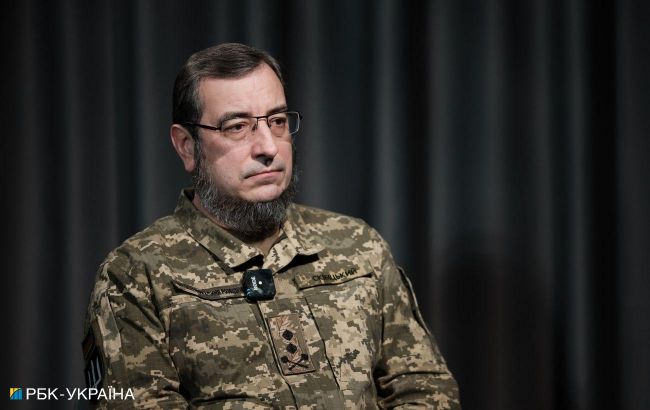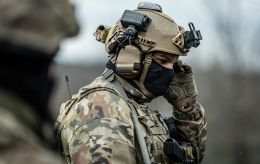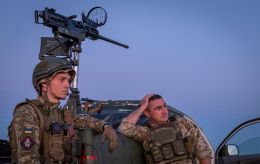Russians motivated to fight for money, 1,000-1,100 people join army every day - Defense Intelligence representative
 Vadym Skibitskyi, a representative of the Main Intelligence Directorate of the Ministry of Defense (Photo: RBC-Ukraine, Vitalii Nosach)
Vadym Skibitskyi, a representative of the Main Intelligence Directorate of the Ministry of Defense (Photo: RBC-Ukraine, Vitalii Nosach)
Vadym Skibitskyi, a representative of the Main Intelligence Directorate of the Ministry of Defense, in an interview with RBC-Ukraine, commented on the goals of Russia's current shelling, how many missiles and Shaheds, the aggressor produces, what military assistance it receives from other countries, and what tasks does Moscow set for itself on the front in 2024.
Since December, Russia has started launching massive missile strikes on Ukraine. However, its current targets are not energy facilities, as last year. Bypassing sanctions and assistance from third countries allow Moscow to continue producing long-range missiles, increasing the production of strike drones like Shaheds, and overall continuing an aggressive terrorist war.
About the current goals of Kremlin missile attacks and tasks on the front in 2024, whether Putin is preparing for a new wave of mobilization in Russia, how Russia helps North Korea, and why Iran is interested in supporting Moscow shared Vadym Skibitskyi, Major General of the Main Intelligence Directorate of the Ministry of Defense.
About the goals of Russia's missile and drone strikes
Currently, the main efforts of the Russian Federation are focused on destroying our military facilities, according to the Main Intelligence Directorate. This includes objects of the defense-industrial complex, headquarters, control systems, and specific units on the front line. However, Moscow often fails to achieve its goals because its missile weaponry is not entirely accurate. Unfortunately, this often results in civilian casualties, as explained by Skibitskyi.
In intelligence, it is warned that the threat of attacks on energy facilities remains. According to Defense Intelligence of Ukraine (DIU), the Russians analyzed strikes on our energy facilities in 2022-2023 and continue to conduct satellite imagery of these objects regularly. They identified the most critical objects that could be affected by missile weaponry and drones.
About the state of the Russian military-industrial complex
In the summer of 2022, Moscow adopted a series of laws and government resolutions, effectively transferring defense-industrial enterprises to a wartime mode. The number of working days per week increased, and some enterprises even operate in three shifts. However, Moscow could not significantly increase the production of weapons and military equipment due to outdated equipment, a shortage of skilled workers capable of performing such high-tech work, and a shortage of components. According to military intelligence, everything produced by Russia today is immediately sent to the front and used against Ukraine.
"The confirmation of the fact that they lack their ammunition is their purchase of ammunition from Iran and North Korea and the export of almost all ammunition from Belarusian depots. If we talk, for example, about artillery ammunition of 122 and 152 calibers, Russian enterprises produced about 2 million such ammunition in 2023. But this does not cover all the needs of the armed formations of the Russian Federation," said the Defense Intelligence representative.

Regarding Russia's missile production
Currently, Russia can produce about 115-130 strategic missiles with a range of over 350 kilometers. However, these production volumes may vary depending on the month. Sometimes, Moscow faces shortages of component deliveries, many foreign-made.
"Secondly, they are now trying to maintain a certain strategic reserve. As a rule, this is about 30% of what they have in stock. Moreover, we understand that everything produced is immediately delivered to the battlefield. Speaking of released cruise missiles, products of the III, and IV quarter of production were recorded during attacks," clarified Skibitskyi.
If we talk about missiles of the operational-tactical class with a shorter range - such as Kh-31, Kh-35, Kh-29, and Kh-59 - they are mainly produced from Russian components. The aggressor can produce approximately 100-115 such missiles.
How many Shaheds Russia produces
Skibitskyi noted that in December, Moscow released a record number of UAVs of the Shahed type in Ukraine – about 770-780 units.
"We are only talking about those that we recorded. Because there is still a certain percentage – approximately 4% – of those that did not reach, did not start, or exploded immediately after launch. We have confirmed data from the Russian side that such cases occur," added the Major General of the Main Intelligence Directorate of the Ministry of Defense.
Previously, Moscow received these drones under a contract with Tehran. However, according to military intelligence, Russia has now established its production, which is already operational, particularly in Yelabuga, Tatarstan. There are at least two production lines deployed there. However, the majority of components for these Shaheds are sourced from other countries.
"The goal of Moscow is to achieve a complete, closed cycle of production of such UAVs on Russian territory by 2026. I'm not sure they can replace or find a Russian analog, such as electronic components – microchips, chips, etc. But the Russian Federation currently manufactures starters, casings, warheads, engines, and other elements of the navigation system," explained Skibitskyi.
According to the agency's estimate, Russians can produce 330-350 units of these UAVs per month. Such indicators, for example, were demonstrated by the aggressor in December. However, they also vary depending on the availability of components, especially engines.
"But, as in the case of missiles, all Shaheds or so-called Geran-2, which are produced, immediately go into combat use. And that's why we see a different number of UAVs being used. December showed that even if the enemy had some reserves, they are now depleted, and all these UAVs that are launched come off the conveyor belt," clarified the Defense Intelligence representative.
Which countries help Russia with weapons
In intelligence, it is stated that Russia received approximately one million artillery ammunition of 122 mm and 152 mm caliber from North Korea. The most active ammunition deliveries from North Korea were made in September, October, and November. At the same time, DIU is verifying information regarding the transfer of ballistic missiles from Pyongyang to Moscow.
Another country that helps Russia is Iran. Tehran's assistance involves the supply of components for strike drones and ammunition. According to Skibitskyi, Iran is interested in military-technical cooperation with Russia because it wants to receive modern aviation, such as the Su-34, training aircraft, and radar stations. Negotiations between them are ongoing.
As for China, almost 80% of components for military equipment, including electronics, reach Russia through fictitious firms created in this country. Moreover, they are not even of Chinese origin in most cases but come from other countries worldwide.
"Russia has tried and is trying to obtain ammunition from China. It also tries to get shells from other countries where Soviet weapons remain, including from Central Asian countries," said the Major General.

About the state and effectiveness of Russian air defense
During the war, the Russian Federation significantly strengthened its air defense on many fronts, including the occupied Crimea, particularly the area around the Kerch Strait Bridge, where a powerful air defense system was deployed. This includes the Moscow direction within the territory of the Russian Federation and other regions. On these specified fronts, reinforcement was achieved, and a layered air defense system was created. However, this was done by redistributing forces and resources from other regions of Russia, such as the Far East, the Northern region of the Russian Federation, etc.
"How effective is it? It is not always as the aggressor claims. Moreover, everything depends on how successfully we plan our operations, including using drones and other weapons. We know to what extent and in which regions the reinforcement of air defense has occurred and where new systems are deployed. The most powerful system they have in service is the S-400, but even it is not flawless. There are cases where their equipment fails. The well-known Pantsir also misses our aircraft, which, as a result, reach their targets," explained Skibitskyi.
What will happen with the war in 2024
One of the strategic goals that Moscow retains for this year is to reach the administrative borders of the Luhansk and Donetsk regions, says Skibitskyi. Another objective for the Russians, according to the documents available to the DIU, is the maintenance of the currently occupied territories: Kherson, Zaporizhzhia, and part of the Kharkiv region.
"Another priority they have set for themselves is the destruction of our air defense system, our aviation, our defense-industrial complex objects, to prevent the growth of our production and the strengthening of the Armed Forces' capabilities. These are the tasks that the Russian Federation sets for itself this year," the Major General explained.
He added that the current conditions for negotiations that Russia wants to push Ukraine into are unacceptable to us. Moreover, this rhetoric about readiness for talks is a trap. The aggressor wants to use this time to restore its potential, build up forces, and create strategic reserves to continue aggression, as in 2014.
"Such rhetoric from Moscow is mostly aimed at Western and Global South countries – suggesting they are allegedly willing to stop and start a negotiation process. But what does Russia say about our occupied territories? Our strategic goal is clear – we must liberate all our occupied territories," explained Skibitskyi.
DIU emphasizes that waging a war against the Russian Federation without the assistance of Western allies is almost impossible. However, the department is confident that this assistance will continue in 2024. Skibitskyi explains that the West understands that Ukraine is currently restraining the "Russian military machine" from preparing for aggression against other countries.
"And they understand that we are genuinely restraining Russia now. It failed to achieve the goals it set for itself. And we have significantly reduced the potential of the Russian Federation. According to our estimates, restoring the potential of the RF Ground Forces, which existed before the start of large-scale aggression, will take them five to ten years. To restore the arsenal of precision weapons, it also takes three to five years," explained Skibitskyi.

Will there be a new wave of mobilization in Russia?
The Main Intelligence Directorate of the Ministry of Defense says that every day, about 1000-1100 people join the Russian armed forces. These individuals join the military through mobilization or voluntarily sign contracts with the army.
In reality, Russians are motivated to join the army, primarily driven by salary considerations, especially in crisis regions where wages are low or there are no jobs at all. This motivation is currently the main factor for those who voluntarily join mobilization, sign contracts, and participate in combat. Those involved in frontline combat earn approximately 220-250 thousand rubles monthly.
However, the 30 thousand people who join the Russian army monthly are primarily sufficient for replenishing losses and forming reserve regiments. But to create a robust strategic reserve, Moscow must declare a more massive mobilization.
"Will Putin dare to do this? Unlikely before the elections. And afterward – we'll see. But all the conditions for conducting mobilization in Russia are created at any time," clarified the Defense Intelligence representative.

